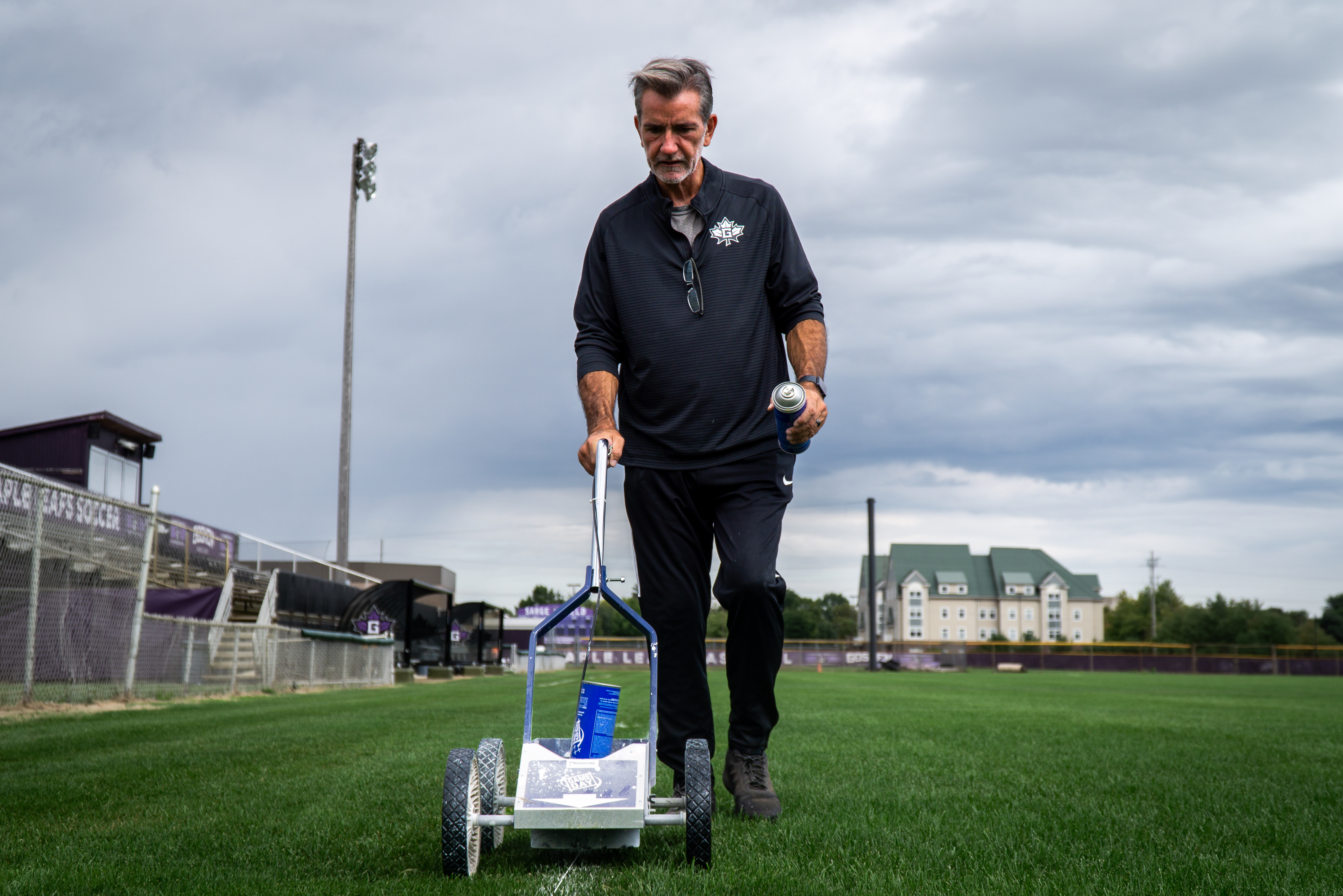The swirl of the purple and white checkered flag as it’s carried around the field, the cheers of the crowd, or the groans as the ball goes out of bounds once again — this is what the average fan sees at a Goshen College soccer game. However, what they might not see is how the grass is maintained for optimal performance, how the trash cans in the bleachers get emptied or how the sidelines are straightened for the ball to sail over.
In fact, most people have no idea what actually goes into getting the soccer field ready to hold its contest, not even the players. Nate Reeser, a member of the men’s soccer team, shared that “I don’t know exactly what goes into the maintenance [of the field].”While there are game day protocols a plenty, the real work actually begins in the middle of April with the start of the “three-step fertilizer program.” This carries on into the summer when the second coat goes down in June, and into the season when the final layer is placed in October.
Craig Johnson, grounds supervisor at GC, already had an extensive background in landscaping. “I worked ten years as a landscape foreman, and I also went to college and got my associate’s degree in horticulture technologies.”
This expertise contributes to all that goes into the highly specific and scientific process of maintenance that goes far beyond just cutting the grass. Even watering the grass becomes a long and arduous process when you are really diligent about it.
It starts in the summer with a trial and error period of seeing exactly how much water the grass will need for that year. It’s all about finding a balance.
As Johnson explained, “The game plan is to give [the grass] enough water to keep it looking nice and alive, but not too much. … We like to have the roots go deeper, looking for water and moisture because it makes a stronger grass.”
After the water is settled and the season is ready to begin, the work really picks up. Not only does the field need to be mowed the morning of every home game, but there is a strategy even in the directions. “One time we’ll mow north and south, and then next time we’ll mow east and west, or a diagonal cut across the field, so that the grass is not cut the same direction all the time because it tends to bend over and lay in that direction,” said Johnson.
When the grass is at an appropriate length, Dan Sullivan and Justin Crew, head coaches of the men’s and women’s teams respectively, then come in to paint the lines on the field. “We try to paint them between each home game” explained Sullivan, making clear the level of commitment necessary, since the task can take a couple of hours if done alone.
While some collegiate coaches might shy away from being required to take on the responsibility of field maintenance, Sullivan was happy to accept the job. “I’ve been painting soccer fields for the last 15 years of my life.”
He spoke positively about the satisfaction that comes with completing the task, as “having a little bit of pride in … putting the work in to get the field set up” was instilled in him even back when he was a player.
He learned early in his career that you have to be willing to put in that work and focus on “not expecting someone else to do it for you.” This is an idea that he is hoping to pass on to his own players.
Right now, both soccer teams in the programs have worked to develop a way to put this in practice. Sullivan explained that “everybody in the program has some task, or they are in a group that is assigned various jobs, whether that’s taking care of the field equipment, the soccer balls, water hydration needs for the team.”
Reeser elaborated that this all takes place on non-game days, so that when getting ready for a match, the players can “just focu[s] on being ready for the game.”
In the long run though, Sullivan is looking forward to changing the culture. “The hope would be that maybe we do get to a point where we’ve empowered some players to take on that responsibility,” he stated, referring to the line painting and other game preparation tasks. “Hopefully [our players] can take a little pride in making their game pitch look as game ready and professional as possible.”
Preparing the field for even one match is no easy feat. Interdepartmental communication, scientific dedication and a willingness to get your hands dirty are all hallmarks of the commitment shown by the entire prep team as they face challenges of their own to prepare the field for play.




